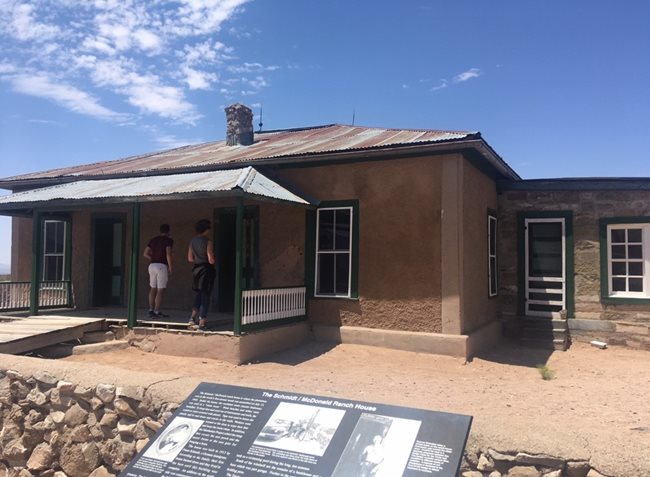July 2019
When the email announcing the tour arrived in my inbox, I knew that I wanted to go. I have my parents to thank for instilling within me an appreciation for history. Whenever we took family vacations, we always found ourselves in museums, learning about people, how they lived, and their impact on society. Given an opportunity like this, it seemed as if I could not pass it up.
I started the day early making the trek up “The Hill”, as Los Alamos is so endearingly called. Situated on top of the Pajarito Plateau, there are few routes to reach Los Alamos and all of them have one thing in common, a steep incline. After all the student interns settled onto the buses, we descended down “The Hill” and maneuvered around Santa Fe and through Albuquerque. By late morning, our caravan of interns had made it to Socorro. It is a small town 51 miles from the site, and the last place to stop before entering the vastness of the Jornada del Muerto region. After our pause for breakfast, we headed back on the road. The further we drove from Socorro the less signs of life we saw, until eventually it was only the highway left to guide us and the terrain to look at.
As we made our way closer to the site, I noticed something peculiar dotting the landscape, cows. Later that day I would learn that it was not surprising that livestock would be in the area, considering that prior to the bomb testing the land was used as a ranch.
There are gates to the Trinity Site. A warning to the public it would seem, since the site is still an active missile range. For public viewing, the site is only open twice a year in April and October. Before we entered, we were cautioned that photos were not allowed until we reached the site. An excitement bubbled among the interns; we had finally arrived. The smell of sunscreen permeated through the bus as hats and sunglasses were put on in eager anticipation. However, as we would soon realize, we still had quite a distance to go until we arrived there. Passing through the gates, the buses began the pilgrimage to the site.
As we traveled further from the main entrance, the road became bumpier. It was clear to see why this site was selected for the detonation test. Simply, there was nothing out here. It was desolate. In the comfort of the bus, the land looked hard and unforgiving. It appeared a place one would not want to navigate alone and definitely not find themselves lost in.

The intern next to me remarked, “I imagine if someone was lost and dehydrated out here the cactuses out there would start to look like people.” Given the situation, what she said seemed true. The cactuses covered the terrain rising in varying heights.
We continued driving. Our destination? Who could tell? By this point, after making several turns down uneven roads, everything blended together. It was hard to tell which direction we had come and which we were headed.
After some time had passed one person perked up, “I see it!”
Everyone shuffled in their seats looking through the windows and down the aisle to catch a glimpse of the site. Out of the desert landscape, the outline of barbed wire fences came into view.

We arrived at another gate and drove down the weathered road into the site. A silence fell upon the bus. On both sides of the path, faded and discolored signs read “Keep Out”. Was this a reluctant welcome or a definite warning?
Finally, the buses parked, and everyone entered in. As we stepped off the buses, we were greeted with an intense heat. The sun bared down on the land. There was no shade anywhere, no respite from the hot weather. Our group gathered around the tour guide as he recounted what it was like here in 1945.


The only landmark at the site is the obelisk which is made of lava rocks. Adjacent to the obelisk is what remains of the 100-foot steel tower that held the bomb.

There are no keepsakes to buy at the Trinity Site. No souvenirs to collect. However, hidden among the dirt is one emblem that remains from that day, trinitite. When the bomb detonated the temperature recorded was 14,710 degrees Fahrenheit. The intensity of the heat caused the sand to melt and form into a green material. If you look carefully you can still find trinitite on the ground today. Though, taking any from the site is prohibited.

The McDonald Ranch House is two miles from the Trinity Site and where the plutonium core of the bomb was put together. The master bedroom of the house was designated as the “clean room”. This is where the two hemispheres of the plutonium core were assembled. The house itself is empty besides various pictures of the scientists working.

What happened at the Trinity Site started the nuclear age and changed the world. I am glad I had the opportunity to visit this place that made such an impact on history.
---Kalifa Stringfield
Kalifa Stringfield is a Masters student in the College of Engineering